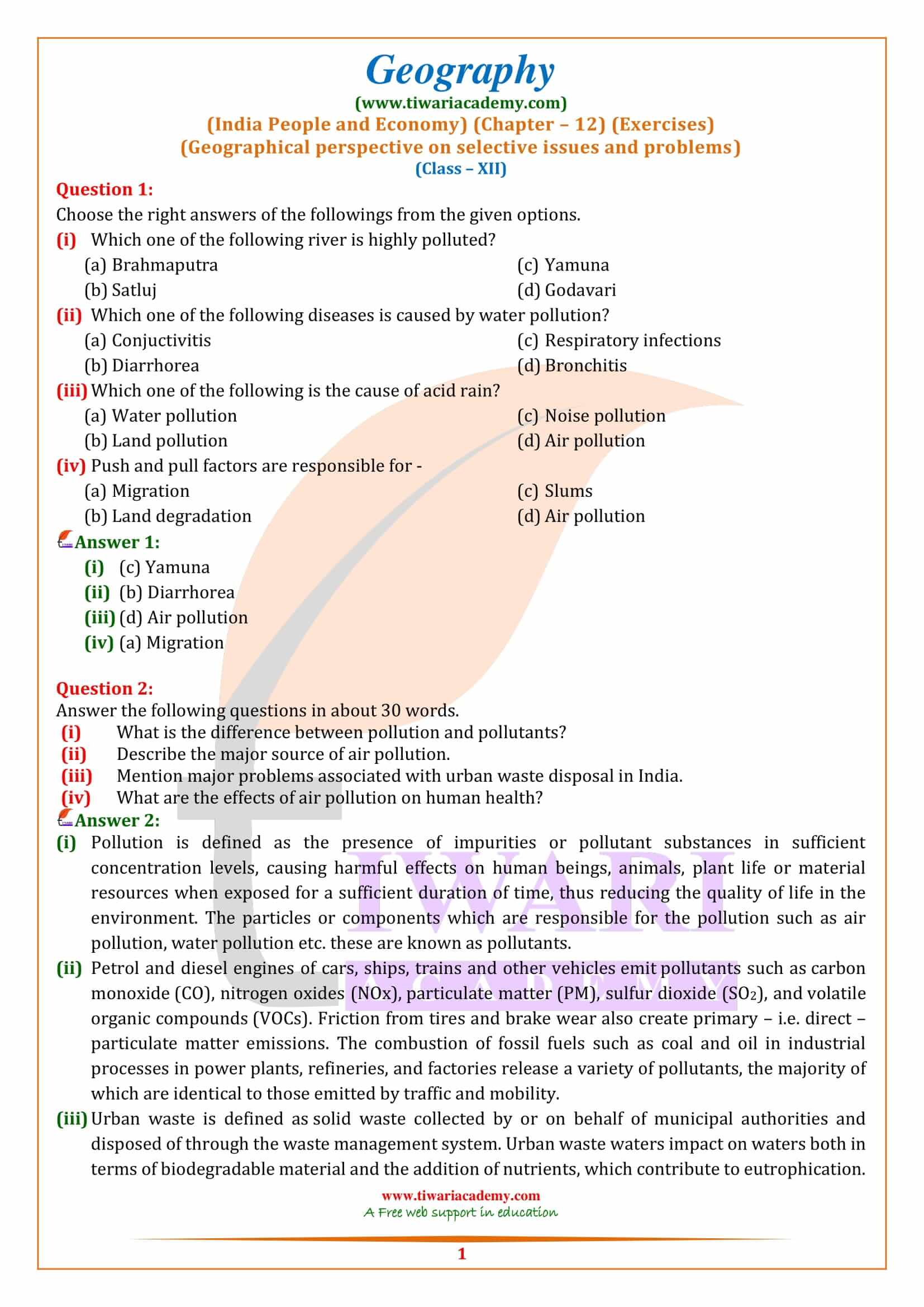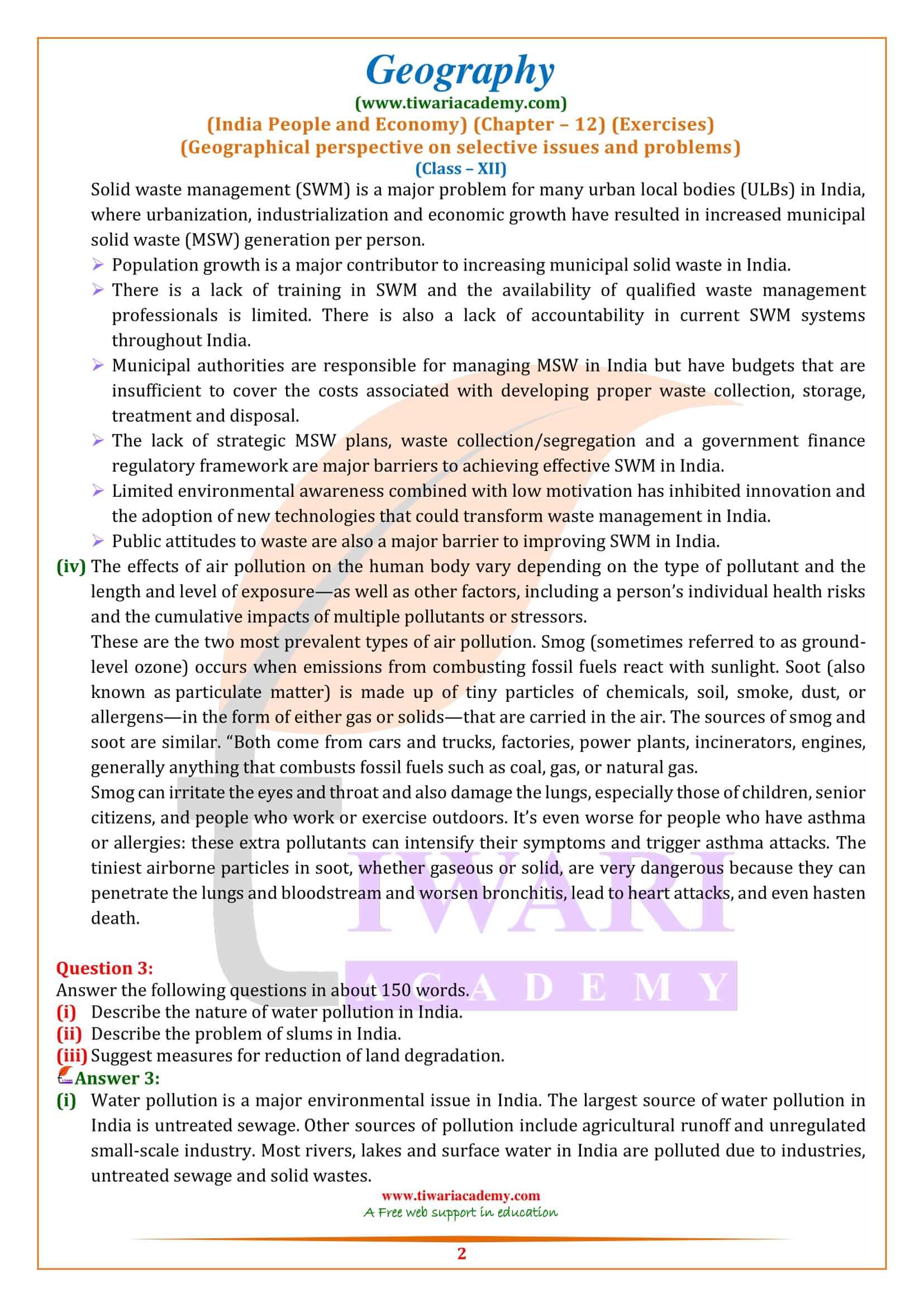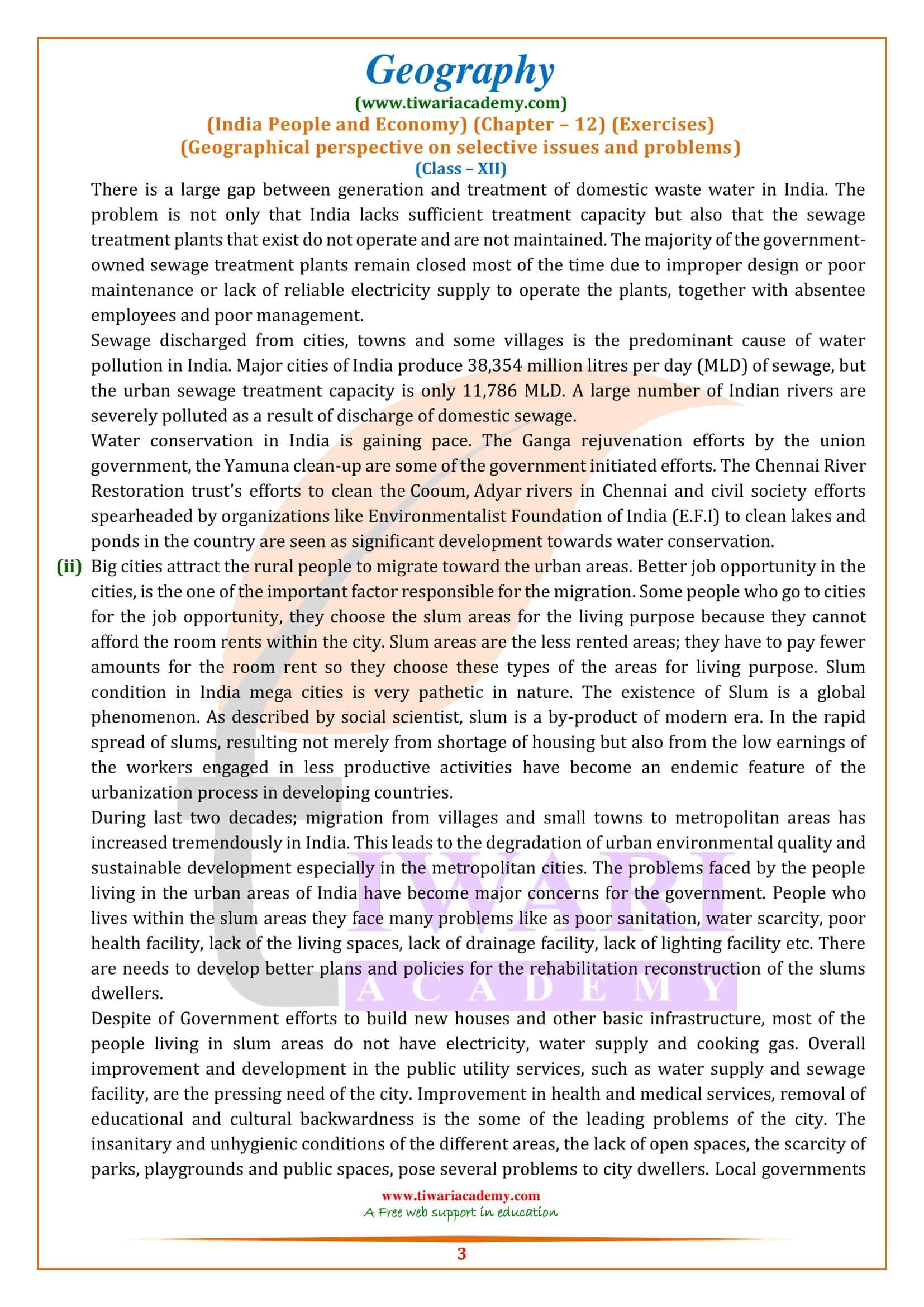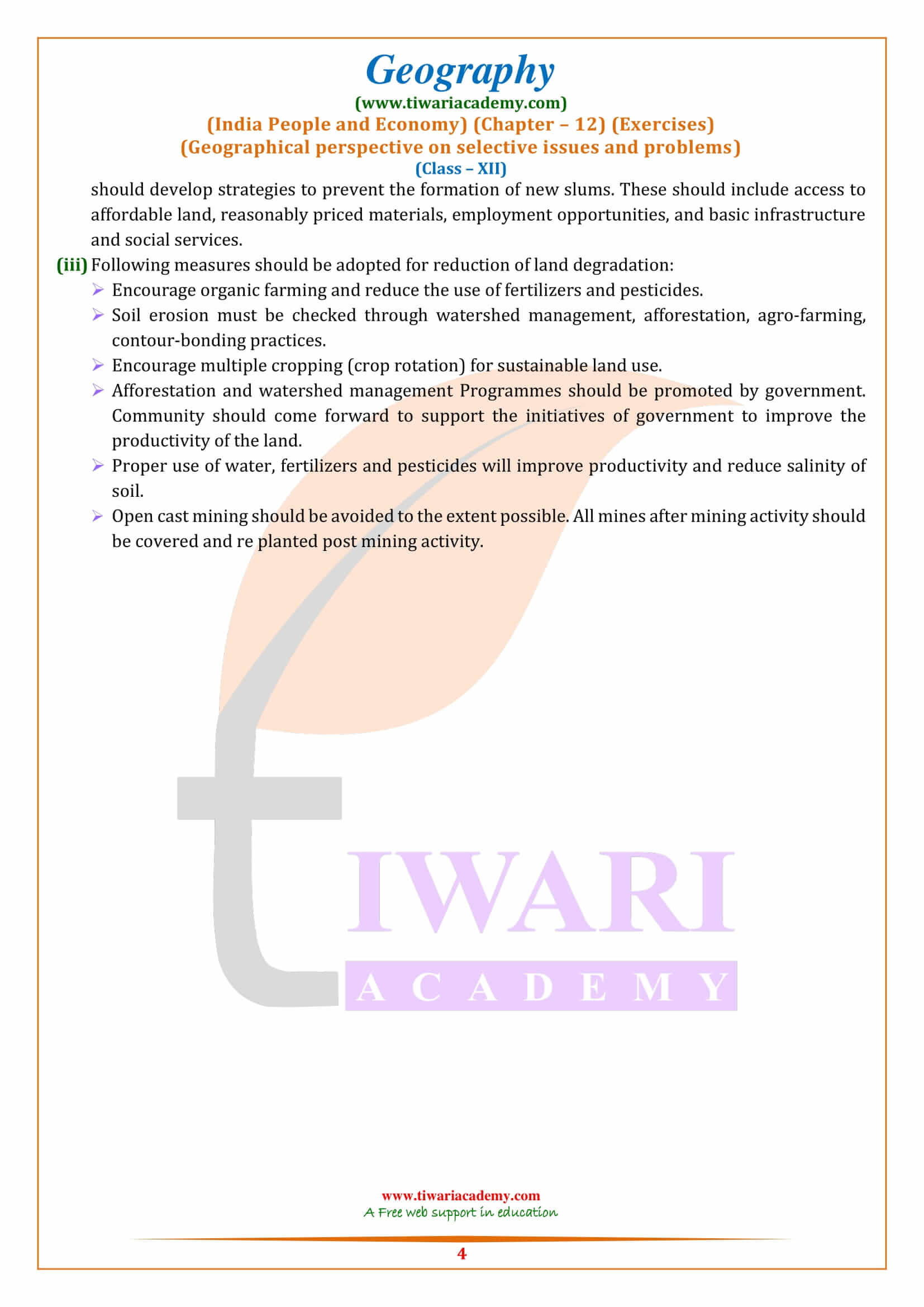NCERT Solutions for Class 12 Geography Chapter 12 Geographical Perspective on Selected Issues and Problems in Hindi and English Medium updated for session 2025-26. Students can prepare here class 12 Geography India People and Economy Unit V Chapter 12 with extra question answers.
NCERT Solutions for Class 12 Geography Chapter 12
Class 12 Geography Chapter 12 Geographical Perspective Question Answers
- Class 12 Geography Chapter 12 NCERT Solutions
- Class 12 Geography Chapter 12 MCQ with Answers
- Class 12 Geography Chapter 12 Important Questions
- Class 12 Geography Chapter 12 Hindi Medium
- Class 12 Geography Chapter 12 NCERT Book
- Class 12 Geography all Chapters Solutions
- Class 12 all Subjects NCERT Solutions
What is the difference between pollution and pollutants?
Pollution is defined as the presence of impurities or pollutant substances in sufficient concentration levels, causing harmful effects on human beings, animals, plant life or material resources when exposed for a sufficient duration of time, thus reducing the quality of life in the environment. The particles or components which are responsible for the pollution such as air pollution, water pollution etc. these are known as pollutants.
Describe the major source of air pollution.
Petrol and diesel engines of cars, ships, trains and other vehicles emit pollutants such as carbon monoxide (CO), nitrogen oxides (NOx), particulate matter (PM), sulfur dioxide (SO2), and volatile organic compounds (VOCs). Friction from tires and brake wear also create primary – i.e. direct – particulate matter emissions. The combustion of fossil fuels such as coal and oil in industrial processes in power plants, refineries, and factories release a variety of pollutants, the majority of which are identical to those emitted by traffic and mobility.
Class 12 Geography Chapter 12 MCQ
Which one of the following river is highly polluted?
Which one of the following diseases is caused by water pollution?
Which one of the following is the cause of acid rain?
Push and pull factors are responsible for
What are the effects of air pollution on human health?
The effects of air pollution on the human body vary depending on the type of pollutant and the length and level of exposure—as well as other factors, including a person’s individual health risks and the cumulative impacts of multiple pollutants or stressors. These are the two most prevalent types of air pollution. Smog (sometimes referred to as ground-level ozone) occurs when emissions from combusting fossil fuels react with sunlight.
Soot (also known as particulate matter) is made up of tiny particles of chemicals, soil, smoke, dust, or allergens—in the form of either gas or solids—that are carried in the air. The sources of smog and soot are similar. “Both come from cars and trucks, factories, power plants, incinerators, engines, generally anything that combusts fossil fuels such as coal, gas, or natural gas.
Smog can irritate the eyes and throat and also damage the lungs, especially those of children, senior citizens, and people who work or exercise outdoors. It’s even worse for people who have asthma or allergies: these extra pollutants can intensify their symptoms and trigger asthma attacks. The tiniest airborne particles in soot, whether gaseous or solid, are very dangerous because they can penetrate the lungs and bloodstream and worsen bronchitis, lead to heart attacks, and even hasten death.
Mention major problems associated with urban waste disposal in India.
Urban waste is defined as solid waste collected by or on behalf of municipal authorities and disposed of through the waste management system. Urban waste waters impact on waters both in terms of biodegradable material and the addition of nutrients, which contribute to eutrophication.
Solid waste management (SWM) is a major problem for many urban local bodies (ULBs) in India, where urbanization, industrialization and economic growth have resulted in increased municipal solid waste (MSW) generation per person.
- Population growth is a major contributor to increasing municipal solid waste in India.
- There is a lack of training in SWM and the availability of qualified waste management professionals is limited. There is also a lack of accountability in current SWM systems throughout India.
- Municipal authorities are responsible for managing MSW in India but have budgets that are insufficient to cover the costs associated with developing proper waste collection, storage, treatment and disposal.
- The lack of strategic MSW plans, waste collection/segregation and a government finance regulatory framework are major barriers to achieving effective SWM in India.
- Limited environmental awareness combined with low motivation has inhibited innovation and the adoption of new technologies that could transform waste management in India.
- Public attitudes to waste are also a major barrier to improving SWM in India.
Describe the problem of slums in India.
Big cities attract the rural people to migrate toward the urban areas. Better job opportunity in the cities, is the one of the important factor responsible for the migration. Some people who go to cities for the job opportunity, they choose the slum areas for the living purpose because they cannot afford the room rents within the city. Slum areas are the less rented areas; they have to pay fewer amounts for the room rent so they choose these types of the areas for living purpose.
Slum condition in India mega cities is very pathetic in nature. The existence of Slum is a global phenomenon. As described by social scientist, slum is a by-product of modern era. In the rapid spread of slums, resulting not merely from shortage of housing but also from the low earnings of the workers engaged in less productive activities have become an endemic feature of the urbanization process in developing countries.
During last two decades; migration from villages and small towns to metropolitan areas has increased tremendously in India. This leads to the degradation of urban environmental quality and sustainable development especially in the metropolitan cities. The problems faced by the people living in the urban areas of India have become major concerns for the government. People who lives within the slum areas they face many problems like as poor sanitation, water scarcity, poor health facility, lack of the living spaces, lack of drainage facility, lack of lighting facility etc. There are needs to develop better plans and policies for the rehabilitation reconstruction of the slums dwellers.
Despite of Government efforts to build new houses and other basic infrastructure, most of the people living in slum areas do not have electricity, water supply and cooking gas. Overall improvement and development in the public utility services, such as water supply and sewage facility, are the pressing need of the city. Improvement in health and medical services, removal of educational and cultural backwardness is the some of the leading problems of the city.
The insanitary and unhygienic conditions of the different areas, the lack of open spaces, the scarcity of parks, playgrounds and public spaces, pose several problems to city dwellers. Local governments should develop strategies to prevent the formation of new slums. These should include access to affordable land, reasonably priced materials, employment opportunities, and basic infrastructure and social services.





